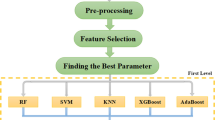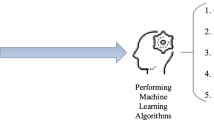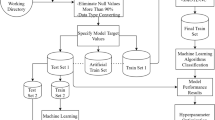Abstract
The regular blood test is the most common and consistent initial test for COVID-19 patients, and the results are quite obtainable within two hours. Due to the high volume of patients admitted to hospitals and the scarcity of medical resources, a regular blood test may be the only way to check for COVID-19 when patients initially visit hospitals. It might be difficult to quickly identify people who are most vulnerable to disease due to improper distribution of RT-PCR-based test equipment. Some tools and resources are required for frequently monitoring patients for optimal treatment. So, keeping up with it regularly is challenging. As a result, a routine blood test allows patients to be monitored daily. In our proposed work, we have attempted to identify the most impacted characteristics that have the strongest effect on the target. So far, we have focused on determining frequently occurring indicators. Then we have used random forest, k-nearest neighbor, decision tree, support vector machine, and naive bayes machine learning approaches and established a stacking technique with those four base learners and one meta learner to effectively justify the outcome. There are four forms of splitting, and each has the best output with an accuracy of more than equal to 84.75%. Based on this, we’ve discovered that Age and LYMPH are commonly active indicators.
Access this chapter
Tax calculation will be finalised at checkout
Purchases are for personal use only
Similar content being viewed by others
References
Coronavirus (n.d.) https://www.who.int/westernpacific/health-topics/coronavirus. Accessed 5 Apr 2022
Wang F, Nie J, Wang H, Xiao Y, Wang H, Liu X et al (2020) Characteristics of peripheral lymphocyte subset alteration in 2019-nCoV pneumonia. SSRN Electron J. https://doi.org/10.2139/ssrn.3539681
Gozes O, Frid-Adar M, Sagie N, Zhang H, Ji W, Greenspan H (2020) Coronavirus detection and analysis on chest CT with deep learning. arXiv:2004.02640 [cs, eess]. Accessed 5 Apr 2022
Li L, Qin L, Xu Z, Yin Y, Wang X, Kong B et al (2020) Using artificial intelligence to detect COVID-19 and community-acquired pneumonia based on pulmonary CT: evaluation of the diagnostic accuracy. Radiology 296(2):E65–E71. https://doi.org/10.1148/radiol.2020200905
Ai T, Yang Z, Hou H, Zhan C, Chen C, Lv W et al (2020) Correlation of chest CT and RT-PCR testing for coronavirus disease 2019 (COVID-19) in China: a report of 1014 cases. Radiology 296(2):E32–E40. https://doi.org/10.1148/radiol.2020200642
Luo J, Zhou L, Feng Y, Li B, Guo S (2021) The selection of indicators from initial blood routine test results to improve the accuracy of early prediction of COVID-19 severity. PLoS One 16(6):e0253329. https://doi.org/10.1371/journal.pone.0253329
Alakus TB, Turkoglu I (2020) Comparison of deep learning approaches to predict COVID-19 infection. Chaos Solitons Fractals 140:110120. https://doi.org/10.1016/j.chaos.2020.110120
Goodman-Meza D, Rudas A, Chiang JN, Adamson PC, Ebinger J, Sun N et al (2020) A machine learning algorithm to increase COVID-19 inpatient diagnostic capacity. PLoS One 15(9):e0239474. https://doi.org/10.1371/journal.pone.0239474
Cabitza F, Campagner A, Ferrari D, Di Resta C, Ceriotti D, Sabetta E et al (2021) Development, evaluation, and validation of machine learning models for COVID-19 detection based on routine blood tests. Clin Chem Lab Med (CCLM) 59(2):421–431. https://doi.org/10.1515/cclm-2020-1294
Ferrari D, Motta A, Strollo M, Banfi G, Locatelli M (2020) Routine blood tests as a potential diagnostic tool for COVID-19. Clin Chem Lab Med (CCLM) 58(7):1095–1099. https://doi.org/10.1515/cclm-2020-0398
AlJame M, Imtiaz A, Ahmad I, Mohammed A (2021) Deep forest model for diagnosing COVID-19 from routine blood tests. Sci Rep 11(1):16682. https://doi.org/10.1038/s41598-021-95957-w
Jiang X, Coffee M, Bari A, Wang J, Jiang X, Huang J et al (2020) Towards an artificial intelligence framework for data-driven prediction of coronavirus clinical severity. Comput Mater Continua. https://www.techscience.com/cmc/v63n1/38464. Accessed 5 Apr 2022
Rahman F, Mehejabin T, Yeasmin S, Sarkar M (2020) A comprehensive study of machine learning approach on cytological data for early breast cancer detection. In: 2020 11th international conference on computing, communication and networking technologies (ICCCNT). Proceedings of ICCCNT, Kharagpur, India. IEEE, pp 1–6. https://doi.org/10.1109/ICCCNT49239.2020.9225448
World Health Organization (2020) Clinical management of severe acute respiratory infection when novel coronavirus (2019-nCoV) infection is suspected: interim guidance, 28 Jan 2020 (No. WHO/nCoV/Clinical/2020.3). World Health Organization. https://apps.who.int/iris/handle/10665/330893. Accessed 5 Apr 2022
Rahman F, Ashiq Mahmood Md (2022) A comprehensive analysis of most relevant features causes heart disease using machine learning algorithms. In: Proceedings of the international conference on big data, IoT, and machine learning, vol 95. Springer, Singapore, pp 63–73. https://doi.org/10.1007/978-981-16-6636-0_6
Author information
Authors and Affiliations
Corresponding author
Editor information
Editors and Affiliations
Rights and permissions
Copyright information
© 2023 The Author(s), under exclusive license to Springer Nature Singapore Pte Ltd.
About this paper
Cite this paper
Rahman, F., Ahmad, M. (2023). Detection of the Most Essential Characteristics from Blood Routine Tests to Increase COVID-19 Diagnostic Capacity by Using Machine Learning Algorithms. In: Ahmad, M., Uddin, M.S., Jang, Y.M. (eds) Proceedings of International Conference on Information and Communication Technology for Development. Studies in Autonomic, Data-driven and Industrial Computing. Springer, Singapore. https://doi.org/10.1007/978-981-19-7528-8_5
Download citation
DOI: https://doi.org/10.1007/978-981-19-7528-8_5
Published:
Publisher Name: Springer, Singapore
Print ISBN: 978-981-19-7527-1
Online ISBN: 978-981-19-7528-8
eBook Packages: Intelligent Technologies and RoboticsIntelligent Technologies and Robotics (R0)




